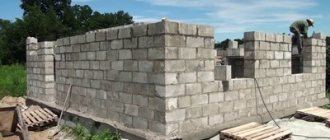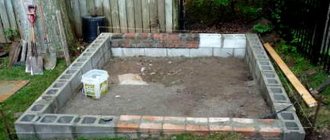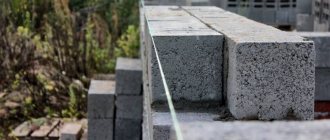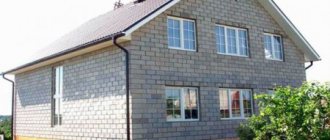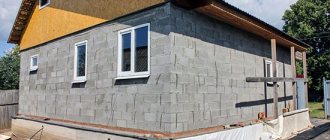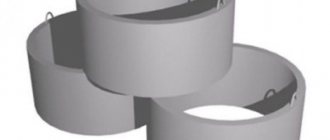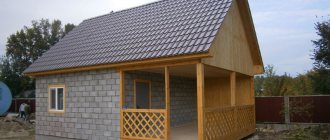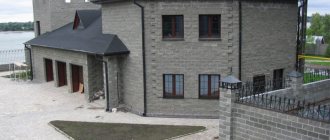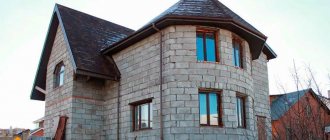At first they treated it with great caution, so they used it for the construction of small utility buildings and garages.
But over time, all its advantages were appreciated and began to be used for individual housing construction.
However, many developers still have conflicting opinions about the benefits of such wall material. In order to dispel them, before making a decision you need to familiarize yourself with the characteristics of this wall material and the basic principles of constructing buildings from it.
Is it possible to build private housing from cinder blocks?
It must be admitted that cinder concrete blocks contain undesirable and even toxic substances . Its main ingredient is considered to be slag. In this regard, it is necessary to build residential buildings from this material with extreme caution.
Since there is no direct ban on the construction of such structures from cinder blocks, more and more developers are building their houses from it. To protect yourself and your loved ones from the harmful effects of slag, before choosing a wall material supplier, you need to familiarize yourself with its certificates.
Cinder blocks are produced in different compositions due to the different origins of the slag. Blast furnace slag, which in most cases is radioactive, is considered especially undesirable for housing construction.
Coal slag from thermal power plants and boiler houses contains sulfuric acid, so for its safety it will be necessary for the material to stand in ventilated open areas under canopies for at least a year so that the acidity erodes from the fresh slag, and only after that they begin to manufacture blocks for construction walls of the house.
General information
Many people believe that building a house on their own is very time-consuming and expensive; it’s easier to buy a ready-made one. In reality this is not the case.
Of course, you will have to carry out all communications yourself, build a fence, and much more. But in the end you will get what you want. Sometimes it takes longer to find a suitable home than to build a new one.
First of all, you should understand that building a house is a step-by-step action plan and only strict adherence to it will allow you to save on construction. The first point of this plan is to calculate the cost.
Please note that if you do not have a plot, then its price should also be added to the cost of construction. It is difficult to give any figures here; it all depends on its area and location. In addition, costs in addition to construction should include the design of the house.
So, to find out how much it will cost to build a house, you need to find out how much you will have to spend on:
- Construction of the foundation.
- Construction of walls.
- Roofing installation.
- Construction works.
The photo shows a strip foundation
Material requirements for construction
Over time, instead of the basic component - slag from coal, they began to add granite chips, broken bricks or hardened concrete mortar, expanded clay or crushed stone.
Cement and sand, clay and gypsum, as well as plasticizing additives are used as a binding element . Competently selected complex cinder block compositions, processed by vibrocompression on a specialized vibroforming machine, make it possible to produce wall material of high industrial quality.
For the production of mass-produced individual houses, technologists have developed optimal sizes of cinder blocks:
- 400x200x200 mm;
- 390x190x190 mm.
Such wall material can be solid or have hollow forms from 28 to 40% . This percentage of voids affects the weight of the block and strength properties. For the manufacture of partitions, blocks are used with a smaller thickness.
How cinder blocks are made
To begin, select the appropriate material. For example, sawdust is lighter in weight and has high thermal insulation. But they can be subject to rotting, and their strength is not too high. It will not be possible to build a two-story house from such material. Cinder blocks made from crushed stone screenings or scrap bricks have other properties. They are able to withstand severe mechanical loads, but their thermal conductivity is higher and their weight is much greater.
Machine for making cinder blocks
When the optimal filler has been selected and stored in sufficient quantity, you can begin to work. First you need to mix the concrete solution. The selected filler is introduced into it. The resulting mixture is poured into molds, after which the mixture is pressed. Wet blocks are removed from the matrices and dried under natural conditions (in a dry and warm place). Typically, concrete dries and gains sufficient hardness in one month.
Features and rules for constructing walls
Cinder blocks are used in the construction of various structural elements of a house: foundation, plinth and walls. The requirements for them will depend on this appointment. The strength parameter is the most important of them. According to GOST, slag concrete blocks are produced with modifications M10 - M125.
The foundation for cinder block houses is built from monolithic blocks M100 and M125, which have increased endurance to withstand a one-story house and a wall of at least 40 cm. It is important to carry out preliminary high-quality waterproofing of the foundation , since cinder block is capable of strongly absorbing moisture.
The basement is also erected from monolithic blocks M100 and M125, no earlier than 7 days after completion of the foundation work. Before laying the 1st row of basement walls, waterproofing is carried out. The height of the seam is no more than 1.5 cm, otherwise it will certainly reduce the heat-insulating characteristics of the basement walls. Work on the plinth is carried out during warm weather.
The walls are erected after the base has stood for a month . For non-load-bearing walls, cinder blocks M25/M35 are used, and for load-bearing walls - M50 or more. To create a separate heat-protective layer of walls, the use of M10 cinder blocks is allowed.
Important! To increase the strength of the walls, they are reinforced. After the walls are erected, construction of the roof begins immediately to protect the cinder blocks from the negative effects of natural precipitation. This requirement also applies to finishing work, both on the outside of the house and on the inside.
Types and disadvantages of cinder block
A cinder block has a standard size of 20x40, it can be a half-block or a block. It is made in the form of a monolith or hollow.
The choice of material depends on the expected load on the building; the higher it is, the more durable the cinder block is chosen.
Before erecting walls, a foundation is installed; it must be created on a flat and durable surface. Its reliability should not be in doubt, so it is laid in clear weather, when there is no precipitation that would prevent the blocks from being tightly bonded together. After the walls are laid, a finishing layer of coating is applied to them. Finally, the roof is installed on the house.
The disadvantages include the following factors:
- it cannot be called an environmentally friendly material;
- decorative blocks need waterproofing, this process is not cheap, it will require certain financial costs;
- It is not easy to create a water supply system and provide it with electricity in such a building;
- the appearance of bare walls does not evoke aesthetic sensations; they need to be covered immediately, which will increase financial costs.
How is a project compiled?
According to the current urban planning legislation, the construction of houses without a design is prohibited . The project can be carried out by a specialized organization that has all the permits to carry out such work. As a rule, projects are tied to a standard version. The customer can choose a standard project he likes, after which it will be tied to real construction conditions.
Factors that will be taken into account when designing a private house made of cinder blocks:
- climatic characteristics of the construction area;
- soil type;
- soil freezing depth;
- location of utility networks and roads in the construction area.
After working through the main sections of construction, performing a technical and economic comparison and selecting building materials, the project will obtain the main characteristics of the house: building area, height, number of floors, area and thickness of load-bearing/non-load-bearing walls and partitions, windows, doors and roofing.
Project sections include specifications for building materials and a set of drawings:
- Architectural planning and floor plans, including roofing.
- Structural on the foundation, roof, walls, stairs with specification of key details.
- Communications, including wiring and connection of utility networks: water, heat supply, sewerage, gas and electricity.
Additionally . The specifications indicate the brand, manufacturer, type and quantity of wall blocks, according to which the developer must purchase cinder block and consumable masonry materials.
Tools for DIY home construction
Construction from cinder blocks does not require special equipment; amateur installers can find most of the equipment:
- Tape measure and pencil;
- Hammer and rubber mallet;
- Saw with large teeth;
- Twine or twine;
- Perforator with mixer attachment;
- Notched trowel and trowel;
- Levels, squares, laser level;
- Scaffolding, trestles;
- Formwork (for casting the foundation).
A concrete mixer will help simplify the work when working with large volumes. Before starting work, the base should be cleared of debris and spilled with water to increase adhesion.
Photo
An example of a two-story cinder block house project:
Project of a one-story house:
Project of a house with a terrace and parking:
How to build a turnkey country house inexpensively. Prices from the manufacturer
For those who are not ready for independent construction and want to devote more time to arranging the site itself and growing various crops, you can purchase an inexpensive turnkey country house. Prices for products can be seen in the catalogs of manufacturing companies. Moreover, manufacturers approach pricing quite differentiated, satisfying the needs of customers with different income levels.
You can purchase a summer house for your dacha inexpensively by ordering the product on the appropriate website. Its cost will be affected by the size of the building, the type of construction and the material from which the house is made. A very tiny country house 3x3 m, the frame of which is made of timber, and the walls are lined with clapboard, will cost only 59,000 rubles.
A small wooden house 5x3 m equipped with a porch under a canopy is offered for 99,000 rubles. A more spacious wooden house with a small veranda and imitation timber trim will require an investment of 270,000 rubles.
Modern design of a country house
Take the time to find a house in the catalog with a design you like and at a price that suits you.
What do you need to prepare for work?
All materials that the developer will need are indicated in the summary specification of the project; as a rule, these are different types of cinder blocks for various wall structures, as well as masonry mixtures.
If the customer has construction experience, has assistants and wants to build a house from cinder blocks with his own hands, he
will need to prepare the following tools :
- an ordinary construction trowel, for masonry mortar;
- measuring instruments for smooth wall laying;
- container for preparing masonry mortar;
- buckets and ladles for collecting and carrying mortar to the construction site;
- a pick to level cinder blocks;
- stretchers for carrying loads;
- individual protection means.
To build a house, you will need a concrete mixer and scaffolding, which are usually rented.
Construction of an economy class panel garden house with your own hands
Often, those who were able to build a garden house with their own hands do not stop there and, after accumulating a sufficient amount of money, build large country houses and even cottages.
There is nothing difficult in building an economy class garden house with your own hands. All you need is to correctly draw up a construction project and, following the instructions, make a garden house step by step. Since the main time spent at the dacha is in the summer, there is no need to build a thick-walled, expensive garden house.
As we said, our house will be economy class, which means we need to choose the appropriate materials (panel or timber). The main construction material is 10 mm plywood sheets (even thicker can be used if desired), 50*50mm timber and insulation (in our case, mineral wool). Let's move on to step-by-step instructions for creating an economy class panel house with your own hands.
Step-by-step instructions with technology features
After the customer purchases the wall material and stores it at the construction site, you can begin preparatory work before starting construction of cinder block walls:
Specify the number of cinder blocks by assortment according to the design specifications.- Check the availability of the required tools.
- Become thoroughly familiar with masonry technology for different types of walls and the method of knitting rows.
- Choose a construction time: with positive temperatures and no precipitation.
- Check the quality of the foundation and its waterproofing.
Laying cinder blocks is carried out in various variations: 1.1/2, 1.5 and 2 blocks. Close attention is paid to the first rows, on which the overall evenness of the wall will depend . Each row is controlled by a plumb line and a building level.
Technology for constructing walls from cinder blocks:
- Laying out the blocks begins with the installation of 4 corners, leveling them with a building level.
- Stretch the twine around the perimeter along which the walls will be installed.
- The method of tying cinder blocks is standard.
- When installing hollow elements, the voids are not filled with mortar. They can install vertical rods or frames for reinforcement for buildings with a height of 3 floors.
- Horizontal reinforcement of walls is carried out every 4th row.
- Plasticizers are added to the masonry mortar to increase the strength of the wall structure. This component also inhibits the thickening process of the masonry mortar and makes it possible to make thin seams so as not to create “cold bridges.”
- After applying the solution, lay the block and beat it with a mallet.
- The mortar that will be squeezed out by the block must be removed using a trowel.
- In areas of technological openings for windows and doors, as well as in areas where floors are installed, a reinforcing belt is made of a reinforced concrete monolithic structure or red brick. After completing the construction of the walls, they give them time to dry and begin the construction of the next floor and roof.
Useful information about cinder blocks
By the nature of its manufacture, a slag concrete block is considered an artificial stone, since its production involves ejection or natural shrinkage in special forms.
The main material is not completely burnt slag and concrete.
In addition, any other bulk materials can be used, for example, expanded clay, sand, gravel, pebbles, as well as brick waste. But there are also various fillers that are added to strengthen the building material. The presence of such components directly affects the strength of the cinder block, and, accordingly, the durability of the building being constructed.
Advantages and disadvantages of such designs
The most key advantage of a cinder block structure is its low cost. The purchase of building materials and the construction of a “cinder block box” will not require significant financial and labor costs from the developer.
In addition, the main advantages of a house made of cinder blocks include :
Possibility to implement any design project.- The blocks are light in weight and do not weigh down the walls, so the house does not require a strong foundation.
- High fire-resistant characteristics of the wall material.
- Easy installation due to precise block shapes and large dimensions.
- Low specific costs of masonry material and low labor intensity of work.
- No special lifting and transport mechanisms are required.
- When using cinder blocks that meet the requirements of GOST and maintaining the technology of masonry work, the house turns out to be reliable and durable.
- Cinder block does not create an environment for mold to grow and is not susceptible to rodents.
- It is immune to ultraviolet degradation and can be exposed to chemical environments without damage.
The disadvantages of cinder block walls include:
- Difficulty in carrying out installation work on introducing utility networks into the house.
- Increased ability to absorb moisture; hydro and vapor protection of walls is required.
- Low thermal and noise insulation characteristics, requires mandatory installation of external thermal protection.
- Increased fragility of walls, and therefore it is not recommended to install heavy equipment on the walls, for example, wall-mounted boilers or water heaters.
- Low environmental characteristics of the material.
In order to reduce the risk of purchasing low-quality cinder blocks, before choosing a wall material manufacturer, you will need to carefully read the quality certificates.
Experts recommend paying attention to the following points when purchasing this building material::
- The material must have environmentally friendly fillers: shell, crushed stone and shavings.
- The integrity of the blocks with binders and fillers - there should be no crumbs or broken pieces.
- The characteristics of raw materials must comply with GOST, especially in terms of strength, thermal conductivity and frost resistance.
- Blocks for residential buildings must be made using vibrating machines.
Attention! The production quality of the blocks can be checked by color; gray color characterizes the presence of cement, black and brown indicate a high slag content.
You can also check the density of the block with a nail 1.5 cm long ; if it fits easily into the block, the quality of the building material is unsatisfactory. Another practical method for checking the quality of a cinder block is to drop it from a height of 1.5 m; if it does not break into pieces, but remains intact and unharmed, then the quality is good.
You can learn more about all the pros and cons of houses built from cinder blocks in another article.
An example of building a country house with your own hands
Let's take a closer look at the construction of laminated timber according to the design of a country house for 6 acres. Photos of such structures can often be found on construction sites.
Our house will have an area of 6x4 m. The house will have a kitchen, a recreation room and a small outdoor terrace with a barbecue oven. It is also used as a heat source in the house in winter.
The timber is treated with antiseptic compounds and stain.
The foundation will be strip and columnar under the terrace. The roof can be made gable under metal tiles. We are building a house on a site where there is no electricity or running water.
Project of a country house measuring 6x4 m
Using a country house in winter requires the construction of a strip foundation, which is much easier to insulate than other types.
There is no need for insulation under the terrace, so it will be enough to install columns there. Glued laminated timber is not very heavy, so the foundation will not be too massive. It makes no sense to arrange it to the depth of soil freezing, since the house will only be visited a few times throughout the winter.
Therefore, we dig a trench under the foundation to a depth of 60 cm.
We install expanded clay insulation inside the perimeter of the tape, so there is no need to raise it to a great height. 20 cm will be enough. Under the stove, a base measuring 100x100x80 cm is poured simultaneously with the main foundation.
The house is lined with decorative stone
For the log house we use laminated veneer lumber with a cross-section of 150x150 mm, therefore the optimal width of the strip will be 25 cm. Under the terrace we put 4 columns with a square cross-section with a side of 25 cm, which are buried 60 cm and have a similar height to the strip foundation.
Small house and outbuilding on a summer cottage
The poured foundation is left to dry for a week, after which the formwork is dismantled and the inner period of the tape is covered with expanded clay. To do this, remove the turf and fertile soil.
They make a sand cushion, which is compacted. Only after this is backfilled to the height of the foundation. For the taken dimensions you will need 4.8 m³ of expanded clay.
Wooden country house project
Various projects of country houses for 6 acres, photos of which can most often be found, have a wide variety of methods for laying timber.
Let's choose the method with cups, like log walls. We lay the first row of timber in such a way that the floor joists extend onto the terrace posts. Inside the house, these logs will be located every 40 cm.
They can be made from 150x150 mm timber. This will allow you to do without installing a subfloor. It will be enough to lay plywood or floor slats on them.
Small country house for summer pastime
On the terrace we make as many joists as we have columns.
Then we will lay a subfloor on them from blocks, on which any covering can be made. The beams of subsequent rows are fastened with dowels. It will be necessary to build walls in 20 rows so that the height is normal.
That is, you will need 80 bars. Half of them are 4 m, and the other half are 6 m. The roof for a country house is made of 50x100 mm bars and covered with metal tiles.
A country house can become a full-fledged comfortable home
Helpful advice! When ordering timber, it is best to immediately count the number of pieces of different lengths so that there is no leftover.
It will take about 1 year for the log to shrink. If the roof is not made immediately, then the frame is pressed with floor beams, which are placed at a distance of 1 m. The corners must be covered with moisture-proof film.
The proposed version of a country house will require certain costs, which will still be much less than when building a full-fledged country house.
Possible difficulties and errors
The biggest problems for the developer are created by poorly manufactured blocks .
In order for them to comply with GOST, the materials that make it up must also have a quality certificate. It is better if the cinder block for a residential building is purchased from a manufacturer, and not produced using a handicraft method.
In addition, a house made of cinder blocks will have poor characteristics, a short service life, and sometimes belongs to an emergency facility if the developer made the following mistakes during construction:
- violation of construction technology;
- low professional level of builders;
- improper waterproofing of walls and foundations;
- low-quality thermal protection of the house;
- violations of the wall reinforcement scheme and lack of armored belts;
- cinder block walls remained roofless in the open air for a long time.
Construction of houses
0 votes
+
Vote for!
—
Vote against!
It is quite possible even for an inexperienced beginner to build a cinder block building on their own. To build, you need to purchase a cinder block or make it yourself. This material allows you to build a home in a short time, because the size of the blocks is quite large, much larger than, for example, brick. The name of the material itself comes from the main component of the material - slag, but now both slag and other compositions can be used. Among the wide variety of materials on the construction market, the construction of buildings from cinder blocks occupies a leading place. Let's take a closer look at how to build a house with your own hands using cinder blocks, how to make the material yourself, and the nuances of this type of construction.
Table of contents:
- Making cinder blocks yourself
- Advantages of cinder block houses
- Features of cinder block
- Disadvantages of cinder block
- Exterior decoration of a cinder block house
- Choosing a cinder block for your home
- Tools for DIY home construction
- Technology for building a cinder block house
Making cinder blocks yourself
If to build a home you decide not to buy building materials, but to make it yourself, you need to prepare for this process and take into account the necessary points:
- Find or make special molds into which the solution will be poured; there should be a large number of them, since the finished products will dry in the molds; the material for the base can be iron or wood.
- The best grades of cement are four or five hundred; the strength of the cinder block, and therefore the quality of the entire building, will depend on the quality.
- Water that will be used to mix the solution.
- Various fillers, which ones are up to you, it can be sand, expanded clay, furnace slag, shavings.
- Devices for creating voids in blocks; bottles or blanks made of any materials are suitable for these purposes.
To obtain a high-quality cinder block, you need to mix the solution in proportions of three to one and five. This will be sand, cement and your chosen filler. It is necessary to insert devices into the mold to form voids and then pour the solution. The blocks will dry for a number of days, which will depend on weather conditions, but it is recommended to remove the blanks after six to eight hours.
In the best case, in a day it will be possible to release the molds for the blocks for the production of the next batch. We stack the freed blocks for final drying; the cinder blocks should be kept for about a month and only after final drying can the walls be erected. But the ideal option would still be not the freshest products, but those that were prepared several months in advance, and even better from the previous season.
Advantages of cinder block houses
A building built from cinder blocks lasts for a hundred years, and these are not just words. There are buildings made from this material that are already a century old, and their quality is still excellent.
Why is cinder block construction considered a priority? Let's analyze:
- one of the most important advantages of such buildings is fire safety;
- If, when building a cinder block house, you do not ignore the issue of reinforcement, then the building will not be afraid of either natural disasters or climate change;
- the material is good because it holds heat well and protects against temperature changes;
- it is easy to repair the building;
- masonry is done faster due to the fact that the size of the blocks is large enough, you can change the thickness of the walls and use masonry in one, one and a half or two blocks;
- construction does not require special knowledge;
- on the Internet you can find various proposals for designing houses made of cinder blocks;
- the building material is not subject to biological destruction and can last for more than a century;
- the blocks are an excellent soundproofing system;
- prices for building materials are affordable.
Features of cinder block
Cinder block can be found in three types - a standard block, measuring twenty by forty centimeters, a half-block and a block with internal voids. Therefore, blocks for construction come in two options:
- monolithic;
- hollow.
Hollow ones differ in the volume of cavities inside the product:
- two rectangular cavities;
- four rectangular cavities;
- two or three rounded cavities;
- three rows of randomly shaped voids.
The strength of the material is marked by the magnitude of the load. If the block has low load-bearing capacity, its use in multi-story buildings is prohibited; high hygroscopicity entails the following requirements:
- do masonry only in good dry weather;
- make masonry only on a sufficiently high foundation - more than half a meter;
- apply the final outer coating immediately after building the walls, the layer thickness should be at least two to three centimeters;
- The frame of the house must be covered with a roof as soon as possible.
Disadvantages of cinder block
Despite the large number of advantages of cinder block as a material for the construction of residential buildings, there are also negative aspects of using the material:
- the appearance of the erected walls is not very attractive and requires a finishing coating that can decorate the building;
- when using blocks with a decorative structure, it requires additional waterproofing, which complicates construction and requires additional financial investments;
- it is not easy to carry out drainage and energy supply;
- it is necessary to insulate the walls, since the material has high thermal conductivity;
- environmental safety is often a big question; if manufacturers used unlicensed brands of fillers, then there may be a possibility of radioactive radiation.
Exterior decoration of a cinder block house
The construction of residential buildings from cinder block is becoming increasingly popular; such construction can be carried out quickly, while cinder block is an inexpensive material, but the looseness of the walls, water absorption, and poor tolerance of temperature changes make it necessary to externally insulate the walls or apply decorative finishing.
Builders claim that if you carry out high-quality external finishing of wall surfaces, this will not only protect the material from adverse environmental influences, but will also help insulate the house. In this case, internal insulation is not necessary.
You can clad a house with many materials; the owner himself decides which one to choose, based on cost and preferences.
The following types of exterior decoration of a cinder block house can be distinguished:
- curtain wall or siding;
- stone cladding;
- decorative plaster;
- brick cladding.
The most inexpensive work is considered to be insulating a house using polystyrene foam and applying plaster and painting.
Choosing a cinder block for your home
If you make cinder blocks yourself, carefully check the quality of the materials. An auxiliary substance such as slag, granotsev or other raw materials must have a quality certificate. A dangerous point when using cinder block construction is the possibility of radioactive radiation. Also, when purchasing ready-made material, check the documents and certificates. Pay attention to the following recommendations when choosing a cinder block:
- when buying blocks, give preference to environmentally friendly fillers - crushed stone, shell rock, shavings;
- when buying ready-made material, check all bundles with cinder blocks to ensure they are identical and intact;
- check the characteristics of raw materials, which directly affect density, frost resistance, thermal conductivity and strength;
- the quality of the product can be checked using a one and a half centimeter nail, if it fits into the lower block - the quality of the building material is questionable;
- a vibrating machine must be used during production, otherwise the blocks will be suitable only for outbuildings, but not for residential premises;
- pay attention to the color of the cinder block - gray indicates a large amount of cement; if the color of the filler predominates, you need to check the quality of the blocks with special attention.
When choosing a cinder block, listen to the advice of professionals who recommend:
- give preference to blocks made at the factory, rather than in unknown places using unknown technology, so you will be confident in the quality of the building material and the reliability of its characteristics;
- There is a way to check the quality of a cinder block - if it falls from a height of one and a half meters and does not break, does not crumble, but remains intact or the edges are slightly chipped, then the block is of very good quality, otherwise there are big questions about the quality of the material.
Tools for DIY home construction
You can build a house with your own hands, without involving a construction team in this process. To do this, you need to prepare theoretically if you are an inexperienced amateur. Surely, there is a person in your circle who will give practical advice on how to build a house from cinder block. First you need to stock up on the necessary tools:
- a trowel for spreading the mortar;
- level to check the correctness of the masonry;
- a plumb line to lay out the wall evenly;
- tub, for mixing the solution;
- shovel, for collecting raw materials;
- a pickaxe for leveling blocks;
- bucket, carry water;
- stretchers, carry heavy materials;
- protective equipment, this could be a respirator and eye protection glasses.
To save effort, experienced builders recommend renting a concrete mixer, since mixing the solution by hand is very difficult and a lot of time is spent on one batch. A day's rent is inexpensive, but you will significantly save energy, health and time.
It is also necessary to think in advance about scaffolding, from which it will be much more convenient and faster to build a house. Laying a cinder block from a stepladder is very difficult, since the weight of the block is on average twenty-eight to thirty centimeters.
Technology for building a cinder block house
The tools have been collected, the material has been purchased, you can get started, but there are still a few things left to be convinced of:
- double-check the number of blocks to make sure there are enough of them;
- check that all necessary tools are available;
- carefully study the masonry technique and methods of connecting rows;
- calculate the forces and time to build walls at the most suitable temperature;
- before starting construction work on the construction of walls, make sure that the foundation is level, if necessary, use brick;
- We must not forget about waterproofing the foundation before laying the first row.
Laying blocks can be done in several ways:
- in one block;
- half;
- one and a half blocks;
- in two blocks.
Particular attention is paid to the first rows; the evenness of the entire building depends on them. After each block, the evenness of the masonry is checked using a plumb line or level. Construction begins with the laying of four corners at once, the height is set to four rows. The rows must be laid using a stretched cord.
When working with hollow blocks, you should remember that the voids do not need to be filled with mortar; their purpose is for thermal insulation.
It is important not to forget about the connection of rows and to use reinforcement. Reinforcement is recommended every four rows.
If, after the walls are erected, it is planned to cladding the external walls, then there is no need to unstitch the seams. But if you are not planning decorative cladding, every two to three rows you need to remove excess mortar from the seams.
You can build a cinder block house with your own hands in a short period of time. If it’s hard to figure out what your future home should be like and make a drawing, you can turn to specialists who will help you plan, taking into account your desires. Drawings of a cinder block house can be found on the Internet or you can come up with it yourself. Flights of imagination and the realization of your desires will help you create your dream home.
Before building a cinder block house, you need to thoroughly study theoretical issues and weigh your strengths. If you are ready, then watching a video on how to build a house from cinder blocks will help you understand the basic issues of purchasing building materials, stages and rules of construction. Upon completion of construction, you will be able to equip your own home, which will allow you and your children, as well as future generations, to enjoy life in it.
Foundation for a cinder block house
The foundation of the cottage must meet a number of criteria:
- Sustainability. A durable structure will last for decades and requires minimal shrinkage.
- Hydro- and thermal insulation. The foundation should not flood and lose energy.
- Possibility of installation of communications. During the construction process, you can save resources by installing sewerage, water supply, and electricity into the house.
Any foundation is suitable for cinder block houses, but installation of the material directly on a sand (stone) base is not allowed. But two of them are considered the best option for the foundation:
- Tape. A massive structure (up to 40-50 cm wide) is mounted only under load-bearing walls.
- Recessed slab. Mounted directly on an area up to 60 centimeters thick, it will provide a level base.
A pile-screw foundation based on metal structures is very cheap and quick to install, but after its installation there will be a large space left under the building. You will have to insulate the house from below, and also monitor the condition of the metal and tint it. A columnar foundation is good for a summer residence, but not for permanent residence.
